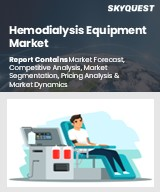
세계의 혈액투석 장비 시장 규모는 2023년에 134억 달러로 평가되며, 예측 기간(2025-2032년)에 CAGR 6.3%로 확대하며, 2024년 141억 2,000만 달러에서 2032년에는 228억 3,000만 달러로 성장할 것으로 예측됩니다.
세계 혈액투석기 시장은 만성 신장질환 유병률 증가와 전 세계 투석 환자 수 증가에 힘입어 강력한 성장세를 보이고 있습니다. 개발도상국의 신장 치료 접근성 향상과 가치 기반 의료 모델로의 전환은 휴대용 및 웨어러블 투석 솔루션에 대한 수요 증가에 기여하고 있습니다. 신흥 시장에서는 의료 시스템이 실시간 모니터링과 우수한 생체 적합성을 특징으로 하는 첨단 모델로 구형 투석기를 업그레이드하고 있습니다. 주요 성장 요인으로는 인구의 고령화, 정부의 상환 정책 강화, 신장학 분야의 디지털 헬스 솔루션 통합 등을 꼽을 수 있습니다. 그러나 높은 장비 비용, 지방의 기술자 부족, 신흥 시장의 규제 장벽, 재택 혈액투석에 대한 문화적 저항 등의 과제도 남아있습니다.
Global Hemodialysis Equipment Market size was valued at USD 13.4 billion in 2023 and is projected to grow from USD 14.12 billion in 2024 to USD 22.83 billion by 2032, expanding at a CAGR of 6.3% during the forecast period (2025-2032).
The global market for hemodialysis equipment is experiencing robust growth driven by the increasing prevalence of chronic kidney disease and a rising dialysis patient population worldwide. Enhanced access to renal care in developing regions and the transition to value-based healthcare models contribute to the rising demand for portable and wearable dialysis solutions. In developed markets, healthcare systems are upgrading outdated machinery to advanced models featuring real-time monitoring and superior biocompatibility. Key growth factors include an aging population, enhanced government reimbursement policies, and the integration of digital health solutions in nephrology. However, challenges persist, including high costs of equipment, technician shortages in rural settings, regulatory hurdles in emerging markets, and cultural resistance to home hemodialysis.
Top-down and bottom-up approaches were used to estimate and validate the size of the Global Hemodialysis Equipment market and to estimate the size of various other dependent submarkets. The research methodology used to estimate the market size includes the following details: The key players in the market were identified through secondary research, and their market shares in the respective regions were determined through primary and secondary research. This entire procedure includes the study of the annual and financial reports of the top market players and extensive interviews for key insights from industry leaders such as CEOs, VPs, directors, and marketing executives. All percentage shares split, and breakdowns were determined using secondary sources and verified through Primary sources. All possible parameters that affect the markets covered in this research study have been accounted for, viewed in extensive detail, verified through primary research, and analyzed to get the final quantitative and qualitative data.
Global Hemodialysis Equipment Market Segments Analysis
The hemodialysis equipment market is segmented into product, end user and region. Based on product, the market is segmented into Hemodialysis Machines (In-center Hemodialysis Machines and Home-Based Hemodialysis Machines) and Hemodialysis Consumables (Dialyzers, Dialysate, Access Products, and Others). Based on end user, the market is segmented into Dialysis Center & Hospital and Home Healthcare. Based on region, the market is segmented into North America, Asia-Pacific, Europe, Latin America, and Middle East & Africa.
Driver of the Global Hemodialysis Equipment Market
The global Hemodialysis Equipment market is experiencing significant growth due to the increasing prevalence of chronic kidney disease (CKD) and a rising preference among patients for home-based treatment options. As healthcare facilities face capacity challenges, many individuals are seeking decentralized care solutions, prompting a shift towards at-home hemodialysis programs. In response, national health authorities are implementing reimbursement policies and telemedicine initiatives that facilitate remote patient management. Leading manufacturers are developing compact and user-friendly dialysis systems with advanced features such as automated fluid balancing and remote monitoring. This evolution is fostering ongoing innovation, thereby expanding the market presence in both developed and emerging economies.
Restraints in the Global Hemodialysis Equipment Market
The global hemodialysis equipment market faces significant challenges due to the high capital investment required for setup, maintenance, and water treatment. Many small and rural dialysis facilities, particularly in Africa, Southeast Asia, and certain areas of Latin America, struggle with inadequate infrastructure and insufficient trained staff to utilize advanced technologies. Furthermore, the elevated costs associated with replacement parts and essential consumables like dialyzers and filters place a heavy financial burden on healthcare providers, even in regions with insurance coverage. This economic strain hinders market growth in resource-constrained areas and slows the uptake of innovative, next-generation dialysis systems.
Market Trends of the Global Hemodialysis Equipment Market
The Global Hemodialysis Equipment market is increasingly shaped by the adoption of digital twin technology, revolutionizing system design, maintenance, and patient care. Industry leaders are leveraging cloud-based digital replicas to enhance fluid dynamics modeling and component aging analysis, thereby optimizing device configurations. This integration facilitates advanced simulations that predict treatment outcomes and identify potential equipment failures before they occur. Remote diagnostics and predictive maintenance capabilities not only reduce unplanned service visits but also significantly improve asset uptime. As a result, the market is witnessing accelerated research and development cycles, leading to smarter, more efficient hemodialysis equipment tailored for both clinical and home settings.